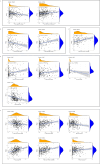Identification roles of NFE2L3 in digestive system cancers
- PMID: 38514488
- PMCID: PMC10957624
- DOI: 10.1007/s00432-024-05656-y
Identification roles of NFE2L3 in digestive system cancers
Abstract
Background: Morbidity and mortality rates of Digestive System Cancers (DSC) continue to pose human lives and health. Nuclear factor erythroid 2-like protein 3 (NFE2L3) is aberrantly expressed in DSC. This study aimed to explore the clinical value and underlying mechanisms of NFE2L3 as a novel biomarker in DSC.
Methods: We utilized data from databases and clinical gastric cancer specimens to validate the aberrant expression level of NFE2L3 and further assessed the clinical value of NFE2L3. To investigate the potential molecular mechanism of NFE2L3, we analyzed the correlation of NFE2L3 with immune molecular mechanisms, constructed PPI network, performed GO analysis and KEGG analysis, and finally explored the biological function of NFE2L3 in gastric cancer cells.
Results: NFE2L3 expression is up-regulated in DSC and has both prognostic and diagnostic value. NFE2L3 correlates with various immune mechanisms, PPI network suggests proteins interacting with NFE2L3, GSEA analysis suggests potential molecular mechanisms for NFE2L3 to play a role in cancer promotion, and in vitro cellular experiments also confirmed the effect of NFE2L3 on the biological function of gastric cancer cells.
Conclusion: Our study confirms the aberrant expression and molecular mechanisms of NFE2L3 in DSC, indicating that NFE2L3 could serve as a novel biomarker for diagnosis and prognosis of DSC.
Keywords: Biomarker; Diagnosis; Digestive system cancers; NFE2L3; Prognosis.
© 2024. The Author(s).
Conflict of interest statement
The authors declare no competing interests.
The authors have no relevant financial or non-financial interests to disclose.
Figures










Similar articles
-
New insight into the CNC-bZIP member, NFE2L3, in human diseases.Front Cell Dev Biol. 2024 Jul 23;12:1430486. doi: 10.3389/fcell.2024.1430486. eCollection 2024. Front Cell Dev Biol. 2024. PMID: 39149514 Free PMC article. Review.
-
Elevated expression of NFE2L3 promotes the development of gastric cancer through epithelial-mesenchymal transformation.Bioengineered. 2021 Dec;12(2):12204-12214. doi: 10.1080/21655979.2021.2005915. Bioengineered. 2021. PMID: 34783304 Free PMC article.
-
Short hairpin RNA-mediated knockdown of nuclear factor erythroid 2-like 3 exhibits tumor-suppressing effects in hepatocellular carcinoma cells.World J Gastroenterol. 2019 Mar 14;25(10):1210-1223. doi: 10.3748/wjg.v25.i10.1210. World J Gastroenterol. 2019. PMID: 30886504 Free PMC article.
-
NFE2L3 promotes tumor progression and predicts a poor prognosis of bladder cancer.Carcinogenesis. 2022 Jun 4;43(5):457-468. doi: 10.1093/carcin/bgac006. Carcinogenesis. 2022. PMID: 35022660
-
NFE2L3 (NRF3): the Cinderella of the Cap'n'Collar transcription factors.Cell Mol Life Sci. 2011 Oct;68(20):3337-48. doi: 10.1007/s00018-011-0747-x. Epub 2011 Jun 18. Cell Mol Life Sci. 2011. PMID: 21687990 Free PMC article. Review.
Cited by
-
New insight into the CNC-bZIP member, NFE2L3, in human diseases.Front Cell Dev Biol. 2024 Jul 23;12:1430486. doi: 10.3389/fcell.2024.1430486. eCollection 2024. Front Cell Dev Biol. 2024. PMID: 39149514 Free PMC article. Review.
References
-
- Asaoka Y, Ijichi H, Koike K (2015) PD-1 blockade in tumors with mismatch repair deficiency. N Engl J Med 373:1979. 10.1056/NEJMc1510353 - PubMed
-
- Bury M, Le Calvé B, Lessard F, Dal Maso T, Saliba J, Michiels C, Gerardo F, Blank V (2019a) NFE2L3 controls colon cancer cell growth through regulation of DUX4, a CDK1 inhibitor. Cell Rep 29:1469–1481. 10.1016/j.celrep.2019.09.087 - PubMed
MeSH terms
Substances
Grants and funding
LinkOut - more resources
Full Text Sources
Medical
Molecular Biology Databases

